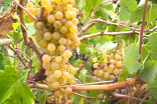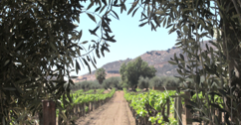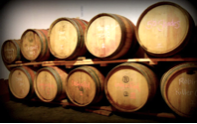 No, they are not characters in a Tom Stoppard play.
No, they are not characters in a Tom Stoppard play.
Palomino and Carignan are grapes, two varietals grown in our own Guadalupe Valley. Their merit is that as “uvas de temporada” or seasonal grapes, they require no irrigation. In the New World, the Americas, irrigation is a widespread and accepted practice. In Europe, it is strictly prohibited under penalty of losing the reputation of your hard-earned appellation. The only irrigation is provided by rainfall which, depending on the whims of nature, is responsible for the differences between vintage years.
 While wracking my brain on which grapes to plant in my modest one-acre vineyard, my childhood memories of rain or its absence in wine regions being the object of national news caused me to pay attention to these two grapes.
While wracking my brain on which grapes to plant in my modest one-acre vineyard, my childhood memories of rain or its absence in wine regions being the object of national news caused me to pay attention to these two grapes.
Palomino is a white grape indigenous to southern Spain which seems to have appeared around the 13th century. It is now also grown in the Canaries. Very adaptable and easy to grow it is used to make sherry and other fortified wines as well as light bodied, low acid table wines.
 Carignan, it is speculated, was a Phoenician grape. It is found in arid regions of Europe and North Africa. It gained popularity in Algeria and was the source of millions of hectoliters destined to the low end of the French market. I was raised to disdain Carignan. It was bad, indeed. How has it acquired a new title of nobility in the Guadalupe Valle by yielding a magnificent full-bodied red? The reason is that in Algeria with growing conditions very similar to those of the Valle, the vinification process was less than optimal. Temperature control, key to a successful product, was nonexistent and passage in a wood barrel unknown, as least for the mass market.
Carignan, it is speculated, was a Phoenician grape. It is found in arid regions of Europe and North Africa. It gained popularity in Algeria and was the source of millions of hectoliters destined to the low end of the French market. I was raised to disdain Carignan. It was bad, indeed. How has it acquired a new title of nobility in the Guadalupe Valle by yielding a magnificent full-bodied red? The reason is that in Algeria with growing conditions very similar to those of the Valle, the vinification process was less than optimal. Temperature control, key to a successful product, was nonexistent and passage in a wood barrel unknown, as least for the mass market.
In the Guadalupe Valley, Palomino and Carignan wines are produced with great success by two Valley natives, Juan Carlos and Toni Bravo. In 2001 they decided to turn the grapes of their ancestral vineyards into their own label.
Ecological as well as practical considerations made me decide on these two varietals for my burgeoning wine growing effort. It was not an easy decision, but the ecological reasons won out. Politically and economically correct, they make sense in a place where scarcity and salinity of the water are an issue. Torn between Palomino and Carignan, I finally opted for the red. The land is being tilled as I write and the plants are on their way. I hope the forecast of a very rainy season comes true or I may have to resort to the practice of rain dancing.
It will be another three to five years before my vineyard produces. In the meantime, you could sample these two magnificent wines at JC Bravo’s tasting room, just off the main road in the heart of El Porvenir village.![]()
 Baja Review A community newspaper serving Ensenada, Valle de Guadalupe, and Rosarito in Northern Baja California
Baja Review A community newspaper serving Ensenada, Valle de Guadalupe, and Rosarito in Northern Baja California



